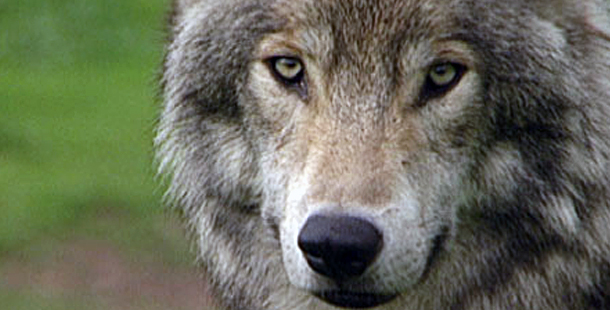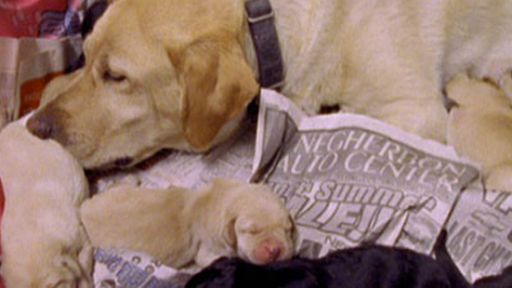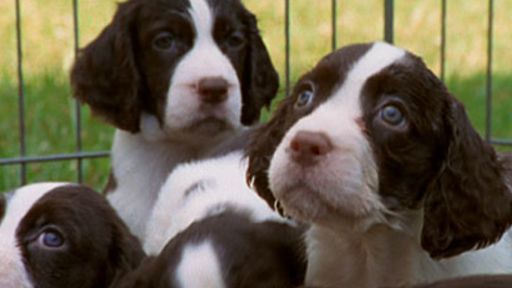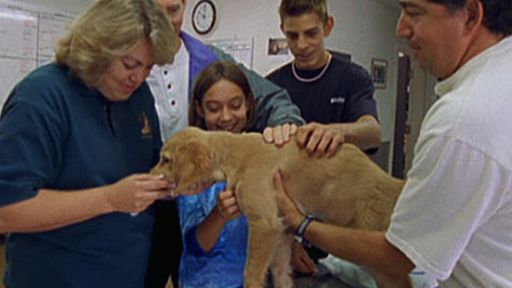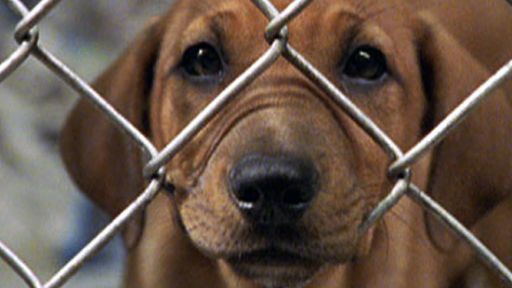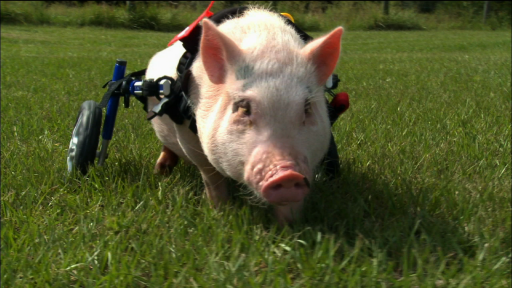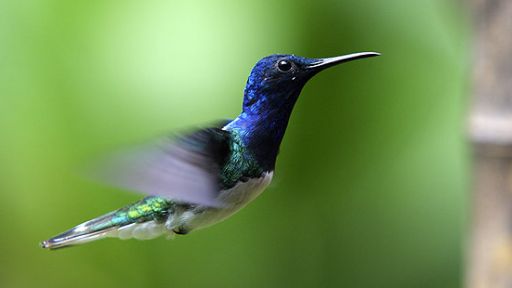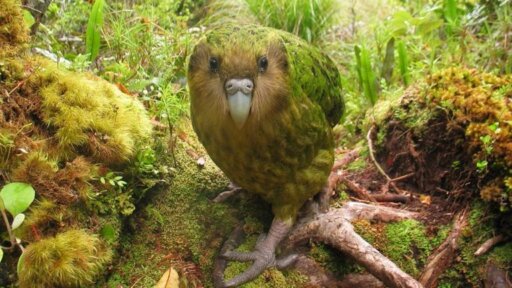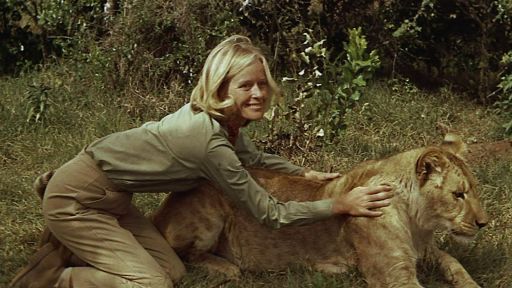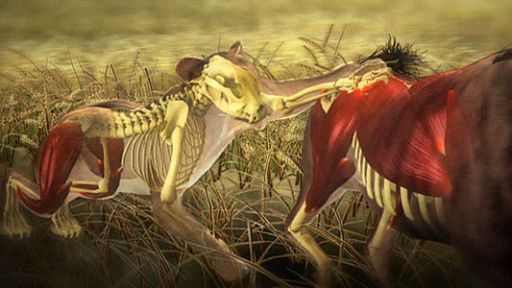TRANSCRIPT
- Hi, I'm George Page.
And this is Angie, a refugee from an animal shelter and the youngest of my three dogs.
She's just over a year old.
I'm convinced she's the smartest, sweetest dog in the world, except of course, for my other two dogs.
Angie doesn't have a real job, but I know she's capable of so much more than I've had time to teach her.
Dogs can do amazing things.
Some accomplish incredible feats every day of their lives, helping the handicapped, comforting the sick, and rescuing people from danger.
There seems to be no limit to their abilities or to how much they have to offer us.
After meeting the extraordinary canines in this "Nature" program, you will never look at dogs the same way again.
[eagle cries] [upbeat music] - [Narrator] This program was made possible by contributions to your PBS station from viewers like you.
Thank you.
- [George] In July, 1991, while Dirk Tennis slept, a fire began in the kitchen.
Spuds, his five-year-old Dalmatian, pulled Dirk gently on his hand until he awakened.
When Dirk was out of danger, Spuds raced back to rescue the family kitten, carrying her outside to safety.
On a spring morning, a five-week-old, Rachel, lay sleeping in her crib.
Suddenly, she began choking.
- [Rachel] Papillon!
- [George] The family Collie, Papillon, ran to Rachel's mother, barking wildly until she followed.
- He saved my life, and I like him.
- [George] Papillon's quick thinking brought help just in time.
- Oh, I like him very much.
He's my good boy.
I like him.
- [George] On a cool September afternoon, Dale Windsor went fishing with his dog, Pooter, in the mountains of Colorado.
He lost his footing, fell into the river, and lay unconscious.
Pooter dragged Dale from the rushing waters, then pulled him up the riverbank to safety.
Thanks to a faithful companion, these two old friends are still enjoying their quiet moments together.
These canine heroes are not alone.
Others are at work every day.
In a small town outside of Seattle, a German Shepherd named Twany joined the family of a teenage boy with cerebral palsy.
From that moment on, his life has never been the same.
- Good girl.
- [George] Dogs do incredible things for us in ways beyond measure.
They offer unconditional love, dedication, loyalty, companionship, and service.
Nothing could be more extraordinary.
This is the story of some incredible canines.
It's a story that begins deep in the past.
Thousands of years ago, our ancestors developed a relationship with a creature of the wild.
[wolf howling] It is no surprise that people and wolves would be drawn together, for we shared so much in common.
Like us, they were intelligent social hunters that lived in small families, closely bonded to each other.
No one knows exactly how the relationship began, but a young pup was probably adopted and cared for.
It became a member of human society, loyal and affectionate to its new pack.
The wild wolf was tamed, and over time it became our best friend.
- Well, [indistinct] the wolf in these dog, they're aggressive, and that's just exactly what the wolf would do.
They're stalking the sheep, wanting to bite them.
We put commands on them, and it takes the bite away from them.
We don't want them to bite the sheep, you see.
We want these dogs to have feeling for the sheep.
- [George] Dogs may not live in packs like their ancestors, but they most definitely have a pack leader.
- Hello, how are you today?
Good boy.
Good morning.
How are you today?
- [George] Raymond McPherson has been working with Border Collies for more than 50 years.
Here, in the north of England, he works his farm with the help of eight dogs.
- Well, this is sort of an extension from the wild.
We have domesticated these animals, but yet they want to have a leader, and I think they regard me as the leader.
Come on there, boys.
- [George] All his dogs have the instinct to herd, but each one has a distinct style.
- Chip is the best.
He's so dedicated, so responsive to commands.
He regards me as the boss, and I don't regard myself as the boss.
We regard each other, that's the way I see it, in a way, as a working partnership.
He's not only a working partner.
He's a friend.
- [George] At the heart of this partnership lies a dog's natural desire to please its leader.
But Border Collies have another deep desire: to help tend the flock.
Though all dogs are shadows of their wolf ancestry, no breed illustrates this more clearly than the Border Collie.
The predator lies just below the surface.
[Raymond whistling] But what makes Border Collies so extraordinary is the powerful combination of instinct and intelligence.
- Border Collies have the finest brain of any animal in the world.
His capacity to take commands and to be trained is beyond all imagination.
If I want my dogs to go left, I say, "Way to me".
Lie down!
If I want my dogs to go right, I say, "Come by."
Lie down!
Way to me.
Lie down!
Come by.
Lie down.
[Ray whistling] They're not dependent on commands all the time.
A lot of people think they're just robots and they need commands all the time.
It's not the case at all.
These dogs can do a lot on their own.
- [George] Working together as a team, the dogs coordinate their movements in perfect harmony, like a pack circling their prey.
Herding is in their blood, and there's nothing they'd rather do.
[Ray whistling] - [Raymond] My dogs are very happy when they're working.
If you watch the expressions on their faces, they tell the tale, how happy they are when they're on the sheep and working the sheep.
If you want to be cruel to them, don't give them any work, and that will break their heart.
[Raymond whistling] - [George] Managing 2,500 sheep is exhausting work, but these dogs never complain.
Border Collies can work a 16-hour day.
Raymond couldn't work the farm without his dogs, and he chooses the next member of his team very carefully.
The pups are born and bred to herd, but each one has a distinct personality.
- That's a wee puppy.
I like a one with a cheeky sort of nature, a bit of the devil in them.
That's the best one in the long term.
There's one stalking another one, funnily enough.
That white-headed one stalking on these other ones.
So that's a start.
So I could guarantee that one will work.
- [George] In a few months, one of these pups will start its new job, continuing an ancient partnership that has endured the test of time.
- [Raymond] There's nothing made by man that could replace the Border Collie.
We're completely dependent on them.
- [George] Thousands of years after our relationship began, we're still relying on the dog's natural abilities to improve our lives, and in some cases to save them.
Specially trained search and rescue dogs could mean the difference between life and death in the Colorado Rockies.
They're on call for that moment when disaster hits the slopes.
After days of fresh snowfall, these mountains are like a time bomb, just waiting to explode.
[snow rumbling] An avalanche starts in a flash.
There's no time to escape.
Anyone caught in its path as little chance of survival.
- [Rescuer 1] Don't spend any time looking at this guy's face.
- [George] In this home video, rescuers and their dogs have just found a skier trapped by an avalanche.
[rescuers conversing] - [George] Buried alive, a person can only survive about 30 minutes.
This time, it was too late.
If they're to have a chance of saving an avalanche victim, the canine rescue teams must practice constantly.
- [Patti] Come on, buddy.
Get him out.
Get him out.
- [George] In this rescue drill, a member of the ski patrol is in a snow cave, six feet beneath the surface.
Hasty, a Golden Retriever uses his powerful nose to find him.
- Good boy.
That's it, boy.
Is somebody in there?
- [George] Patti Burnett from Copper Mountain Resort is Hasty's owner and trainer.
They've been working together for 10 years.
Mounds of snow may all look the same, but they don't all smell the same, at least not to Hasty.
A dog's sense of smell is thousands of times more powerful than our own.
- Good boy.
Let's get him out.
What I'm trying to do with him is, because this is deeper, I want him to narrow it down to a more exact location.
Sometimes, when the dogs are alerting, the tail actually will go in a circle.
Right now, he's so intent on his work that it's not wagging quite as much as it normally does.
There It goes.
- [George] In a real rescue mission, Hasty would bring the first breath of fresh air.
- Get him, Hasty.
- [George] Retrievers love to fetch, and Hasty works hard to get his reward.
- This is just a tug toy.
The dogs really enjoy tugging, and so we have to give 'em some kind of a tangible reward after they've found the person.
So we'll tug with them.
They get the idea that they've gotta get this tug toy though from the person in the hole.
- [George] Hasty is a skilled professional, but that didn't happen overnight.
Like these puppies, he began training when he was only a few months old with a simple game of hide and seek.
- Hi, good boy!
The idea here is to make a real simple, easy exercise for the dog to solve so that they can learn that the game is fun.
We want to always have them winning the game and be willing to play.
Good boy, Hunter.
Good Doggie.
Good boy.
Good boy.
The purpose of this exercise is air sensing.
What we're trying to do here is to get the dog to be able to find us without falling our trail.
An avalanche victim doesn't leave a trail.
Get him, Hunter!
Get him!
Go boy, go!
That a boy!
Come on, Hunter, come on.
Good boy!
- [George] Soon, these youngsters will have to learn a few things which don't come quite so naturally.
They'll have to join the ski patrol wherever they go.
The name of the game is getting to the scene as quickly as possible.
- [Patti] The dogs have built up quite a reputation at Copper Mountain.
It's really funny if we're running down the hill and they're coming on the chairlift overhead, they'll yell down, "Hey, there's Hasty!"
or, there's Skate or Sandy.
These dogs love their work.
- [George] These dogs may be having fun, but their efforts could be an avalanche victim's only hope.
No one on this team will give up that hope.
[dog whimpering] - Good boy.
He got an alert here.
- [George] These practice drills keep them ready for the real thing.
- 1, 2, 3, okay.
Okay, we're gonna wrap you up.
We're gonna get you out of here and into place warm, okay?
Go ahead and ride down the road with him.
- [George] By adding helicopters to their teams, rescuers have a fighting chance to get the dogs to the victim on time.
Search-and-rescue dogs are at work all across the country, finding the victims of avalanches, earthquakes, or a child lost in the woods.
Nothing can replace their skills and dedication.
Even when we humans bring trouble on ourselves, we can still rely on our loyal friends for help.
- If I hadn't have been a dog handler and Cracker hadn't have been there, I wouldn't be here today.
I'd be somewhere on the east wall of Vietnam Veterans Memorial with a lot of other people up there.
And if it hadn't been for my dog, I wouldn't have made it.
- [George] Bob Hemrod fought in the Vietnam War.
At the age of 18, he joined a special branch of the military, the Scout Dog Platoon.
And from that moment on, he worked side by side with his new partner, a young German Shepherd.
Her name was Cracker.
Cracker was just one of thousands of other dogs who joined soldiers in combat.
Dogs have been helping us fight our wars nearly as long as we've been having them.
In World War I, as many as 75,000 canines were used to carry messages and search the battlefield for wounded.
By World War II, it was clear that dogs were a great asset to the military, but trained dogs were in short supply.
The U.S. Army needed dogs quickly and asked the public for help.
More than 40,000 pets were donated to the war effort.
The dog of choice was the German Shepherd because of its stamina, intelligence, and strong temperament.
Like all soldiers, they first had to go through rigorous training.
Whatever the breed, war dogs needed to be in top condition and ready for anything.
The military found uses for every facet of the dog's natural instincts: keen senses of smell and hearing, endurance, speed, and loyalty.
Even when seriously wounded, many dogs kept running to finish the job they were asked to do.
As scout dogs, they were used to detect the enemy and warn of approaching danger.
Canines in combat, loyal and intelligent members of the armed forces.
As weaponry advanced, one might expect that dogs would become obsolete.
Nothing could be further from the truth.
Vietnam was a gorilla war of stealth and ambush.
Scout dogs were needed more than ever.
There was still one thing they could do better than any military invention: detect a hidden enemy.
To the army, dogs were tactical necessities.
To the soldiers, they were faithful companions.
A strong bond quickly developed between dog and handler, a bond that grew stronger every day.
Bob Hemrod was a handler in the 49th Scout Dog Infantry Platoon.
His first assignment was to choose his canine partner.
One in particular caught his eye.
- Her name was Cracker, and her military brand number, or tattoo on her left ear, was 60X1.
That's how they identified the dogs.
The other dogs were like, hi, how are you?
And then, went off about their way.
But she stayed and wanted to play and be friendly, and I guess that friendship's what kinda chimed me into her.
The handler and the dog had to be basically one and the same, and you became a team.
So you got totally dependent on one another.
She looked at me for her protection.
I looked to her for my protection.
On mission, we would get up in the helicopter and she always got real excited because of the noise and the rotors going.
And she'd jump right up in the helicopter and we'd fly off and then fly into a landing zone.
I had to be careful 'cause she just about pulled me out of the helicopter a couple of times.
When you get in a firefight and you're just, horrific.
[indistinct] dozen people are trying to kill you and you don't know what kind of trap they've set for you.
Without the dogs, you'd have walked into stuff.
- [George] Bob Hemrod and Cracker had been able to stay one step ahead of their enemy until a fateful day, nearly 30 years ago.
- In August of '68, I think it was the 19th, we were doing a search-and-destroy operation south of Saigon about six miles out, and our basic mission was to sweep the area and make contact or find enemy weapons caches.
We were tasked to walk a dyke and sweep the bank of a river down there.
I had to lead [indistinct] and put my Cracker on harness, and she started working.
And she had been somewhat fatigued already because we worked some other areas.
I had walked up another, oh, 10, 20 feet into this heavily vegetated area.
There was a tree limb or branches across the trail there.
Cracker just went underneath the branches and stood up and we heard a distinct popping sound.
When she bumped her limbs, I went to turn to get away and the thing went off.
And she's gagging while still standing, and I yelled for the medic to get up there, and she walked back about five feet and laid down.
The vet said I could put her out right now or let her suffer and die here.
So I said, "Well, give her the needle."
And he put the needle in her, and she went real quick.
Just before she went, she kind of looked up and looked me in the eye, and I'm not sure whether it was a betrayal or a goodbye.
But any case, she died.
This is something I've kept all these years.
That's her branded name, Cracker 60X1, I put on there about 28 years ago.
And this is the leash I had on the end of my hand.
And as you can see, there's numerous shrapnel wounds, just metal buckles bent over.
This was six feet away from the explosion plus the dog.
If she hadn't been there and caught all this fragmentation, I don't think I'd be here today.
That was my closest friend over there.
It's not very many people that save your life and die on you all on the same day, and that's just what happened here.
- [George] It is estimated that the dogs who served in Vietnam prevented 10,000 deaths and casualties.
From the moment our relationship began, we've been finding new roles for dogs in our lives.
Canine Companions for Independence, located in California, trains service dogs to help the disabled.
Before this puppy is accepted into school, he has to take an entrance exam, a temperament test to evaluate his personality.
A service dog should enjoy being with people and accept their leadership, and he must remain calm under almost any circumstance.
Some dogs will make it and some won't.
- [Trainer] Hey, hey!
- [George] The students here are all Labrador and Golden Retrievers, chosen for their easygoing nature and their instinct to retrieve.
One of the hardest exercises is learning to ignore distractions.
For a Retriever, nothing is harder to resist than a bouncing tennis ball.
- [Trainer] Down, down.
- [George] These lessons teach them to focus on their work.
When one student is allowed to have some fun, the others can only watch and wait their turn.
- [Trainer] Don't.
- [George] They must learn that there is a time for work and a time for play.
- [Trainer] Don't.
Down.
That's good.
Release, release!
That's it, release!
That's it, release!
- [George] After months of training, they can resist almost any temptation.
- [Trainer] Leave it.
Good boy!
- [George] Students can only eat when they have been given permission.
- Okay, Arnold.
Arnold, get it!
Good.
- [George] Soon these dogs will be helping the disabled with everyday tasks that most of us take for granted.
- Get it!
That's it.
Here.
Give.
Thank you.
Good boy.
Up!
That's it.
Switch.
Yeah, good job!
- [George] The need for graduates is so great that there is a long waiting list.
- Great.
Fully up.
Light.
That's it.
Get it.
- [George] But fortunately, this is not the only school for service dogs.
Other canines are learning the same skills, but in a very unusual setting.
In Washington State, at a correction center for women, dogs live in prison.
Their trainers are inmates, all of them convicted felons.
[lock clicking] - [Trainer] Put!
Oh, good boy.
That's very good!
- [George] The Prison Pet Partnership Program, directed by Jeanne Hampl, gives both inmates and dogs a second chance.
- [Trainer] Very good boy, touching that.
- [George] The women learn job skills and the dogs are saved from almost certain death.
All these dogs were rescued from shelters.
Now, they will offer someone the chance for a better life.
The inmates often train with volunteers and people looking for service dogs.
Pure bred or mutt, it makes no difference, as long as the dog has a good temperament and a desire to please.
- [Trainer] Good girl!
Bring it.
Good girl.
Bring it, bring it.
Good girl.
Good girl.
- [George] For women like Yvonne, this is a 24-hour-a-day job.
The dogs live with the inmates in their small cells, but she knows her hard work will make a valuable contribution.
- [Yvonne] Let's go.
The things that we teach 'em here in the institution, they're gonna go out and they're gonna utilize that with someone who needs that, as a part of their life.
That's how they're gonna get by on a day-to-day basis.
And that's just really fulfilling inside, knowing that by me teaching one of my dogs how to open a door, when she gets placed with a person, that's how they're gonna get in and out of life.
- [George] One year ago, Twany was placed with Chad Norris, a 14-year-old boy with cerebral palsy.
They've come back to polish some of her skills.
- [Carolyn] How you doing?
Hi there.
- [George] Chad's visit reunites some old friends.
Carolyn was Twany's trainer.
- [Carolyn] The first time I saw 20 come back in with Chad for training, oh, I was really happy.
I was just...
I don't know.
I was almost in tears, but I was just happy to see something that I did that was good.
There you go, sweetie.
In the beginning, there was little problems.
She was a stubborn little girl.
But she turned out to be a pretty good dog in the end.
- [George] Twany and Chad were paired up after a careful evaluation of both their personalities.
It was a perfect match.
But training is an ongoing process, one that's difficult for both of them.
They're still learning how to work together as a team.
- [Trainer] Tell her to wait.
You go across to where you drop the food the last time.
- [Carolyn] She's helping him a whole lot.
She's giving him independence where he don't have to have other people helping him as much.
She's there for him.
- [Chad] Pause.
Good girl!
- [Carolyn] It makes me feel really good to know that not only did I help save her, but I'm helping someone else.
- [George] Chad is in the 8th grade, and in a way, so is Twany.
They face the challenges of school together.
- When Twany came into our lives, the burden every day of handling with a handicapped child just seemed to lift.
She was a blessing to us.
For the first time in Chad's life, he's able to go and do things on his own now.
She goes everywhere he goes.
It seemed like when Twany came into the picture, he blossomed.
His whole life was changed.
He had something that meant something to himself.
[children singing] Twany has helped Chad more than just working for Chad.
- You sound just like them, except you jump down further.
[piano resounding] - [Chad's Mother] Twany has helped Chad come out of the shell that he was in.
- [Teacher] Ready?
And go.
- [Chad's Mother] She's just brought friendship all over him because he is able to communicate with people.
[bell ringing] And by communicating, asking questions about his dog, they say, "Hey, this kid's not so bad after all.
He can talk just like you and me."
- A lot of hands.
This is great.
Okay, here we go.
Describe snakes, okay.
We can go the good things and the bad things about snakes.
Chad?
- I've got two of them.
They smell with their tongues and they eat rats.
- Very good.
Okay, Derek.
- They eat eggs.
- [Teacher] Good.
Okay, let's do a real quick review here, then I'll let you go.
- [Chad's Mother] For the first time in Chad's life, he's able to do things on his own now.
If he drops something, Twany's there.
When I see Chad and Twany together, it's just every mother's wish that her son has somebody to walk beside him.
- [Chad] Give.
Wanna go play?
Sit.
Give me a big kiss.
Aw, yeah, I love you too.
Yes, I do.
Wanna play, huh?
- [George] Dogs like Twany trained to help those outside the prison gates have also transformed the lives of those on the inside.
Watching the progress of their trainees gives the inmates a sense of responsibility, accomplishment, and self-esteem.
The program also provides them with skills they can use when they're released.
Besides training the dogs, they also learn boarding and grooming.
- Rambo!
Come on, hold still.
[razor buzzing] - I get out in 17 months, and I go to work release in 11 months, and this is something I'll be able to do through work release.
- The whole program's like a win-win situation.
Here I am and I'm in prison, and I've been here for a long time, and there's a lot of people who would look down on me because of that.
And he, and Lex too, down there, they were gonna die because nobody wanted 'em.
The whole program let's me give back to society, show that I'm not all the way bad.
- [George] But these dogs are more than trainees.
They are friends, offering moments of intimacy that help these women cope with prison life.
- The animals in the institution are an unconditional love for anybody who has any dealings with them.
They are something that you could just hold onto, tell your worst stories, your fears, your remorses, anything you want, and they'll always be there.
- [George] Yvonne's dog also offers her something else quite remarkable.
Yvonne has seizures, and Cinder can actually detect them before they occur.
She's being trained to warn her of an oncoming seizure.
- Cinder, front.
- [George] No one knows what dogs like Cinder are perceiving, although they may sense a chemical change in a person.
- [Yvonne] Sit.
Very nice.
Let's go.
Cinder came in alerting.
She is the perfect dog.
She is a physical alerter, and she is very sensitive to my emotions and what's going on.
She knows where to go to get help.
- [George] Each seizure alert dog has its own way of telling its owner that something is wrong.
Cinder tries to get Yvonne's attention and block her path.
- [Yvonne] What?
- [George] She also becomes noticeably concerned.
- What?
The dogs will let me know that I'm in an unsafe area or an unsafe situation, whether I need to sit down, lay down, or they need to get some assistance.
- [George] Cinder's alerting allows everyone to be more prepared for a potentially dangerous situation.
While "Nature's" crew was filming at the prison, Yvonne had a seizure.
- Rachel, get this blanket under her head.
Put it under her head.
- [George] The trainers use this opportunity to teach Cinder what to do until Yvonne is safe.
- That a girl.
You're doing fine, baby.
- [George] Though she wants to lick her face, Cinder has to learn to stay calm and wait by Yvonne's side.
- That's it.
The seizure dogs, they alert naturally.
And so what we do is we try to teach 'em appropriate behavior so they're not in the way and they're not all over.
- Good job, Yvonne.
It's over.
- [George] People with alert dogs never have to go through a seizure alone.
- [Yvonne] After the seizure, when I have my dog, I cuddle up to her.
It's just like a big Teddy Bear, something that's really comfortable and something that I know.
So I can just go ahead and I can sleep or I can totally come out of it and I know that she's there and she's watching.
- [George] Only some dogs seem to possess this remarkable sixth sense, and there are many people who could use their skills.
Cinder will be placed with someone who needs an alert dog in only a few months.
Yvonne will then begin training a new dog.
Even though they know how much their dogs will be helping someone, saying goodbye is never easy for any of the inmates.
- When you hand them over that first time, and they're getting ready to walk out the door, that's really hard.
We usually go back to the room and cry.
That's why, a lot of times, Jeanne will have another dog for us right away.
We'll usually have another dog in the kennel waiting for us for when that dog leaves if it's gonna be a hard one.
- For me, it's really hard to let my dogs go.
It's like you put out everything.
It's like having a child go away to college and you're missing them or not seeing them.
A lot of women in here have children that they don't get to see, and this is our children that we don't get to see anymore.
We've raised them.
We've taught 'em everything that we know how to do, or the best that we could do.
And a lot of times we don't get to see 'em again.
They're enhancing someone else's life and making it better, but it's still a chunk of ours that goes.
Cinder's gonna be one of my harder dogs to let go, just because that bond was so quick and so tight and everything she does is what I would want if I had one.
But she's gonna enhance someone else's life, and she's gonna make an excellent seizure alert dog for someone.
[dog barking] - [George] There are about 50 million dogs in the United States alone.
What if they were all given the same opportunity?
Here, in the suburbs of Maryland, two ordinary pets are getting ready for work.
- Come on, guys!
Here!
Good boy, Scooter.
Come on!
- [George] First, they have to take a bath.
Few dogs are so eager to get soaked, but these two know that bath time means they'll soon be on their way.
Molly and Scooter work as therapy dogs, visiting people in hospitals.
Before each visit, they have to get squeaky clean.
- Yes, that's a good boy.
Oh, yes, thank you so much.
- [George] Sue Patrick volunteers with her dogs because she knows how much they can help patients.
- They have a sixth sense about them.
If you're sick, they wanna just give you love.
They wanna lay down next to you and just love you.
If you're happy, they wanna play.
And they also know when you're sad, and that's why they make great therapy dogs.
- [George] A few times each month, Molly and Scooter visit the National Institutes of Health.
These two small dogs are more powerful than they appear.
They are treatments in huggable form.
Therapy dogs come in all shapes and sizes.
They just need to be well-behaved and friendly.
The owners all gather with their pets until it's time to head off on their appointed rounds.
The children at the clinical center have serious illnesses.
They've come here for experimental treatments which could save lives.
- [Sue] Some of these children are hospitalized for such long periods of time, and you're just bringing a little joy into their life.
When the children don't feel good and you bring the dogs in, it's the look on their face.
- I was in the hospital for a month.
Now, I really miss my dog at home.
When the dogs came in, they jumped right into my bed and just licked me, and that made me feel a lot better.
- [Sue] While they're administering the chemotherapy, it makes them sick and it hurts, and of course, that's upsetting to the children.
So the dogs act as distraction.
When he's doing a good job, say, "Good boy, Scooter."
- Good boy, Scooter.
- [Sue] You're doing such a good job walking him.
Can you tell Scooter to heel?
- Heel - The patients here get unconditional love out of participation in our pet therapy program.
One of the things that I've noticed with my patients is that they perk up when the dogs come into the room.
Quite often, it's the only time that they have any kind of contact in bed with another living thing, as opposed to lines and tubes.
- [Sue] Hi, Bernie.
How are you?
- Hi, how are you?
- [Sue] Hi, Scooter's come to visit you today.
You ready for a dog visit?
- [Bernie] Yeah.
- [Sue] Ready?
Scooter's ready to stay hi to Bernie.
Okay, Scooter sit.
Scooter down.
Scooter down.
Good boy.
Oh, boy, has he been waiting all day for this.
Oh, there he goes.
As soon as you stop, he hits you with his paw and says, "More and more!"
- They really made a big difference.
There were times that Bernadette was in so much pain and just so sick.
She didn't want to eat.
She didn't wanna play.
There just wasn't anything that could get her out of the doldrums.
The only thing that made a difference was her knowing that the dogs were coming.
When everybody else from the clinic goes home, and you're left here with this little girl, who's in a lot of pain and just won't respond to anything, when a dog comes in and jumps up on the bed and gets her to smile and just open up and be yourself again, it really makes a difference.
- [Sue] Brian.
Hi, Brian.
- [George] Unconditional love, acceptance, moments of joy and laughter, no one word can summarize all that Molly and Scooter offer these children, but it's something only a dog can give.
[Brian laughing] What makes dogs so extraordinary?
Is it something they're born with, some physical ability?
Is it their desire to serve, or their devotion and tolerance?
Is it their intelligence, or their endless desire to please?
- [Dog Owner] Hold it!
Good, hold it.
- [George] And what is this bond that draws us together?
Is it something we will ever understand?
Do we really need to?
Whatever it is, it seems like it will last forever.
Every dog has something incredible to offer, yet so many are never given the chance.
Millions of dogs are brought to shelters every year in the U.S. alone.
Though most will never find a home, many are being rescued every day by someone looking for a new best friend.
- I want that dog.
- You want him?
- [George] What gift will this puppy bring its new owner?
- Wanna hold him?
- Yes.
- [George] Only time will tell, but there's no doubt it will be something extraordinary.
- [Narrator] This program was made possible by contributions to your PBS station from viewers like you.
Thank you.
[upbeat music]

